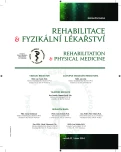Effect of Asymmetric Load on Running Stereotype
Authors:
D. Holíková; D. Pánek; D. Pavlů
Authors‘ workplace:
Katedra fyzioterapie UK FTVS, Praha, vedoucí katedry doc. PaedDr. D. Pavlů, CSc.
Published in:
Rehabil. fyz. Lék., 21, 2014, No. 1, pp. 38-43.
Category:
Original Papers
Overview
This is an experimental work aimed at evaluating the electromyographic activity of selected muscles with and without load on the treadmill and co-current assessment of the impact of asymmetric load on lateral weight distribution. The research was conducted on 6 recreational runners, and the load was placed on the periphery of the right upper extremity. The following muscle groups were recorded by surface electromyography: m. deltoideus pars anterior, m. trapezius pars ascendens et descendens, paravertebral lumbar muscles, the gastrocnemius lateralis and tibialis anterior. All probands demonstrated decline in the average amplitude of the normalized EMG signal at left-sided m. gastrocnemius lateralis. The reduced level of activity of this muscle is most probably expression of compensatory mechanism of the body, which is needed to maintain the same stride length and height of the center of gravity during the flight phase of the stride.
Keywords:
endurance running, surface electromyography, asymmetric load, transport of fluids
Sources
1. ARELLANO, C. J. et al.: Does load carrying influence sagittal plane locomotive stability? Medicine & Science in Sports & Exercise, 41, 2009, 3, s. 620-627.
2. COTTALORDA, J. et al.: Influence of school bag carrying on gait kinetics. Journal of Pediatric Orthopaedics B, 12, 2003, 6, s. 357-364.
3. GRAVES, J. E. et al.: The effect of hand-held weights on the physiological responses to walking exercise. Medicine and Science in Sports and Exercise, 19, 1987, 3, s. 260-265.
4. HEUSCHER, Z. et al.: The association of self-reported backpack use and backpack weight with low back pain among college students. Journal of Manipulative and Physiological Therapeutics, 33, 2010, 6, s. 432-437.
5. CHANSIRINUKOR, W. et al.: Effects of backpacks on students: Measurement of cervical and shoulder posture. Australian Journal of Physiotherapy, 47, 2001, 2, s. 110-116.
6. CHUMANOV, E. et al.: Changes in muscle activation patterns when running step rate is increased. Gait & Posture, 36, 2012, 2, s. 231-235.
7. LAFIANDRA, M. et al.: How do load carriage and walking speed influence trunk coordination and stride parameters? Journal of Biomechanics, 36, 2003, 1, s. 87-95.
8. MARNIX, G. J., GAZENDAM, M. G., HOF, A. L.: Averaged EMG profiles in jogging and running at different speeds. Gait & Posture, 25, 2007, 4., s. 604-614.
9. MCGILL, S. M., MARSHALL, L., ANDERSEN, J.: Low back loads while walking and carrying: comparing the load carried in one hand or in both hands. Ergonomics, 56, 2013, 2, s. 293-302.
10. MYERS, M., J., STEUDEL, K.: Effect of limb mass and its distribution on the energetic cost of running. Journal of Experimental Biology, 116, 1985, s. 363-373.
11. NAILK, G. R.: Computational intelligence in electromyography analysis – A perspective on current applications and future challenges. InTech, 2012.
12. NEGRINI, S., CARABALONA, R.: Backpacks on! Schoolchildrenś perception of load, associations with back pain and factors determining the load. Spine. 27, 2002, 2, s. 187-195.
13. OWENS, S. G., AL-AHMED, A., MOFFATT, R. J.: Physiological effects of walking and running with hand-held weights. The Journal of Sports Medicine and Physical Fitness, 29, 1989, 4, s. 384-287.
14. ÖZGÜL, B. et al.: Effects of unilateral backpack carriage on biomechanics of gait in adolescents: a kinematic analysis. Acta Orthopaedica et Traumatologica Turcicca, 46, 2012, 4, s. 269-274.
15. PÁNEK, D., PAVLŮ, D., ČEMUSOVÁ, J.: Počítačové zpracování dat získaných pomocí povrchového EMG. Rehabilitace a fyzikální lékařství, 16, 2009, č. 4, s. 177-180, ISSN 1211-2658.
16. PASCOE, D. D. et al.: Influence of carrying book bags on gait cycle and posture of youths. Ergonomics, 40, 1997, 6, s. 631-641.
17. SASAKI, K., NEPTUNE, R. R.: Differences in muscle function during walking and running at the same speed. Journal of Biomechanics, 39, 2006, s. 2005-2013.
18. WANG, J. S., ROEMMICH, R. T., TILLMAN, M. D.: Lower limb coordination is altered during asymmetric load carrying while walking on a treadmill. [online]. c2012,[cit.2013-04-08].Dostupné http://www.asbweb.org/conferences/2012/abstracts/371.pdf
19. WINDHAM, W., LUDWIG, K.: Running impulse, functional strength and dynamic balance asymmetry in healthy recreational runners. Journal of Strength and Conditioning Research, 25, 2011, s. 95-122.
Labels
Physiotherapist, university degree Rehabilitation Sports medicineArticle was published in
Rehabilitation & Physical Medicine

2014 Issue 1
- Hope Awakens with Early Diagnosis of Parkinson's Disease Based on Skin Odor
- Deep stimulation of the globus pallidus improved clinical symptoms in a patient with refractory parkinsonism and genetic mutation
Most read in this issue
- Respiratory Complications in Patients after Spinal Cord Injury and their Management at the Spinal Cord Unit in University Hospital Motol
- Qualitative Evaluation and Testing in Patients after Lower Extremity Amputation
- A Study in Typical Changes of Peripheral Circulation during Application of Vacuum-Compression Therapy
- The Influence of Morphological Variables of the Foot on Kinematics of the Gait
